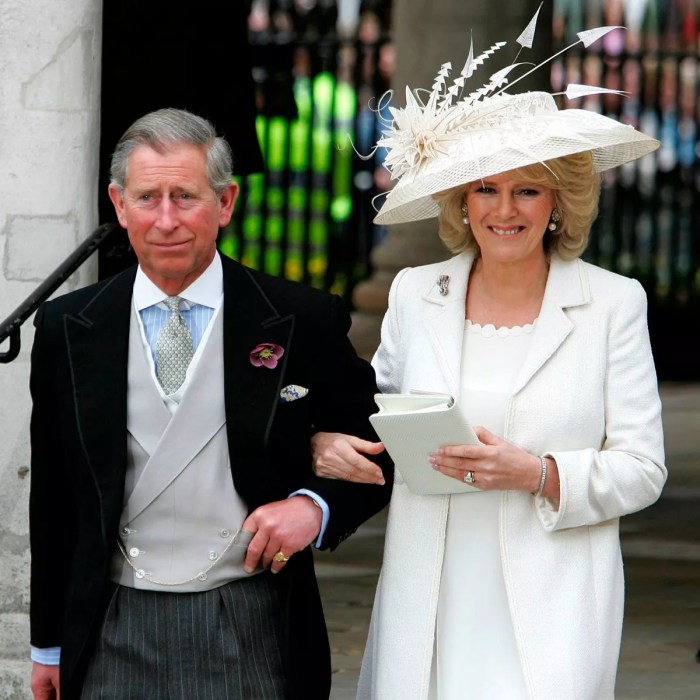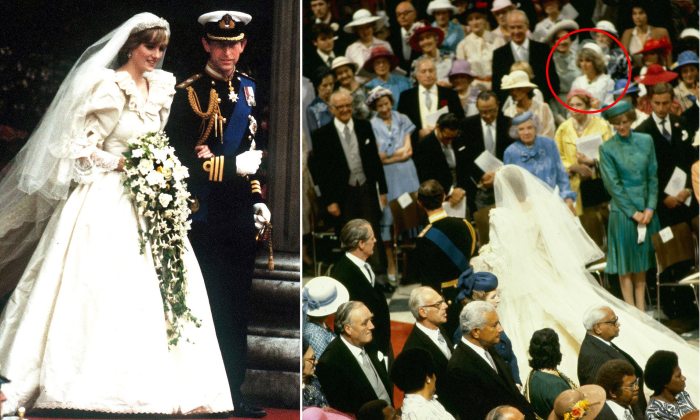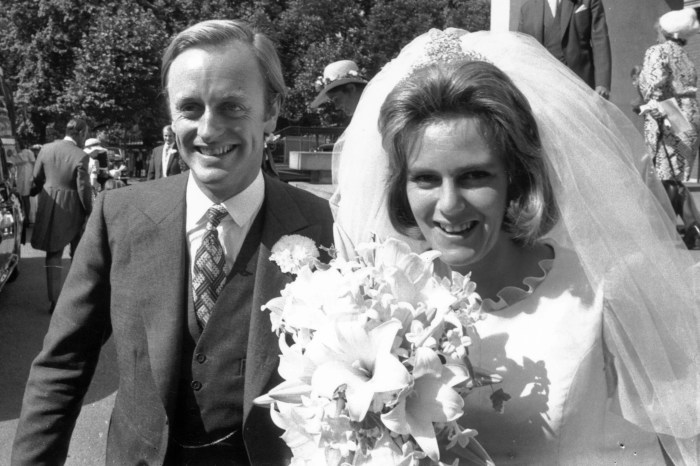Camilla Parker Bowles’ Wedding Dress: Camilla Parker Bowles Wedding Dress
Camilla parker bowles wedding dress – Camilla Parker Bowles’ wedding to Prince Charles in 2005 was a significant event, not only for the couple but also for its impact on royal traditions and public perception. Her choice of wedding dress, a departure from the elaborate gowns of previous royal brides, sparked considerable discussion and continues to be a topic of interest. This analysis delves into the design, creation, context, reception, and lasting legacy of this notable garment.
The Dress Design & Inspiration

Source: co.uk
Camilla’s wedding dress was a bespoke creation, reflecting a more understated elegance compared to the dramatic styles often associated with royal weddings. The silhouette was a simple, elegant sheath, showcasing a sophisticated and mature aesthetic. The ivory silk was chosen for its luxurious texture and timeless appeal; silk holds a long-standing association with high-fashion and royalty. Key design elements included delicate embroidery, subtly placed to avoid overwhelming the simple lines of the dress, and a modest, bateau neckline.
Unlike the voluminous gowns and dramatic trains seen in some previous royal weddings, such as Princess Diana’s iconic dress, Camilla’s choice was characterized by its restrained elegance, perhaps reflecting her personal style and the different context of her marriage.
Potential inspirations for the design could include the classic elegance of 1950s and 60s haute couture, known for its clean lines and luxurious fabrics. The understated embellishments might also hint at a preference for understated luxury, rather than ostentatious display.
The Designer and Creation Process

Source: co.uk
The designer of Camilla’s wedding dress remains undisclosed, adding to the mystique surrounding the garment. While the specific details of the creation process are largely unknown, it’s likely that the design and creation involved a collaborative effort between the designer, seamstresses, and possibly even Camilla herself. Considering the simplicity of the dress’s design, the process may have been relatively straightforward compared to the elaborate creations of some other royal wedding gowns.
Camilla Parker Bowles’s wedding dress, a sophisticated choice of ivory, contrasted sharply with the bolder choices some brides make. It’s interesting to consider alternative bridal styles, such as the dramatic impact of a blood red wedding dress , a color rarely seen at royal weddings. In contrast to this vibrant option, Camilla’s understated elegance reflected her personal style and the occasion’s formality.
A hypothetical alternative design could have incorporated a more structured silhouette, perhaps a classic A-line or ballgown, retaining the ivory silk but adding more intricate lace or beading. This would have created a more traditional royal wedding look, although it might have detracted from the dress’s understated elegance.
Information on the designer’s other notable works is unfortunately unavailable due to the lack of public information regarding the dress’s creation.
The Wedding and its Context, Camilla parker bowles wedding dress

Source: vogue.com
The wedding ceremony took place at the Guildhall in Windsor, a more intimate setting compared to some grander royal weddings. The overall aesthetic was one of understated elegance, reflecting the couple’s preference for a less formal and more personal celebration. The color palette was primarily ivory and neutral tones, enhancing the elegance of the dress and the overall mood of the event.
The dress’s significance within the broader context of the wedding was to reflect Camilla’s personal style and the mature, understated nature of the event, a departure from the grand spectacle of previous royal weddings.
A timeline of key events leading up to and following the wedding would include the announcement of the engagement, the planning and preparations for the ceremony, the wedding itself, and the subsequent public appearances of the couple.
Public Reception and Legacy
Initial public reaction to the dress was mixed. While some praised its understated elegance and appropriateness for the occasion, others felt it lacked the grandeur expected of a royal wedding gown. However, over time, the dress has gained a more positive reception, often being cited as a testament to Camilla’s personal style and her preference for classic elegance. Its lasting impact lies in its demonstration of a modern approach to royal wedding attire, moving away from traditional expectations.
The dress has been referenced in various media, solidifying its place in popular culture and fashion history.
| Year | Dress Designer | Public Reaction | Lasting Impact |
|---|---|---|---|
| 2005 | Undisclosed | Mixed; some praised the understated elegance, others found it lacking in grandeur. | Demonstrates a modern approach to royal wedding attire; considered a testament to Camilla’s personal style. |
| 1981 | David and Elizabeth Emanuel | Overwhelmingly positive; iconic and highly influential. | Remains one of the most famous and influential wedding dresses in history. |
Visual Elements and Description
Camilla’s dress was a sheath silhouette, crafted from ivory silk with a subtle sheen. The texture was smooth and luxurious, enhanced by delicate embroidery that added a touch of shimmer without being overly ornate. The bateau neckline was simple and elegant, complementing the dress’s overall understated style. The accessories were minimal, allowing the dress to take center stage. A simple veil and understated jewelry completed the look.
A visual representation of the dress would show a slender, flowing sheath, the ivory silk falling in graceful folds. The embroidery would be subtly scattered across the bodice and skirt, adding a touch of sparkle. The bateau neckline would frame the shoulders elegantly. The overall impression would be one of sophisticated simplicity and timeless elegance.
The symbolic meaning of the design elements is open to interpretation, but the simplicity and elegance could be seen as representing Camilla’s mature and understated style, and the choice of silk could be interpreted as a nod to tradition and luxury.
Question & Answer Hub
What type of neckline did Camilla Parker Bowles’ wedding dress have?
While specifics are limited, descriptions suggest a relatively simple, possibly modest neckline, avoiding excessive embellishment in keeping with the overall understated design.
Who made the wedding dress?
The designer’s name is not always widely publicized, requiring further research to confirm. Information about the designer’s background and other notable works would further enhance the understanding of the dress’s creation.
Was the dress a bespoke design, or was it adapted from an existing design?
This detail is often omitted from readily available information and requires further research to ascertain whether the dress was a completely original design or based on a pre-existing template.
What kind of fabric was used in the dress?
Information on the exact type of fabric is typically limited in publicly available sources. Detailed accounts from fashion experts or those involved in the creation of the gown are needed for a definitive answer.
